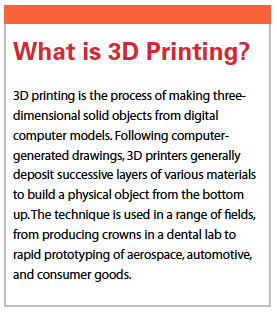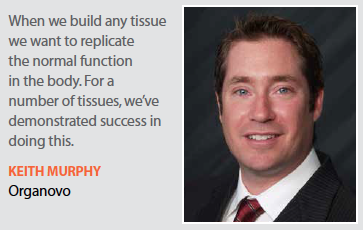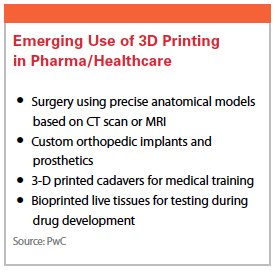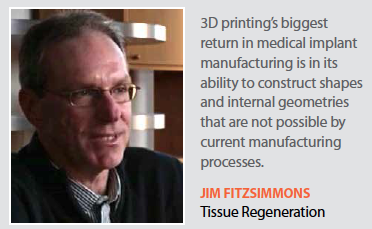Three-dimensional printing is no longer simple plastic prototypes. Today, 3-D printers can produce fully functional  components, including complex mechanisms, batteries, transistors, and LEDs. 3D printing — also known as additive manufacturing — is the process of making three-dimensional solid objects from digital computer models. Following computer-generated drawings, 3D printers generally “print" layers of materials to build a physical object from the bottom up. The process is used in a range of fields, from producing crowns in a dental lab to rapid prototyping of aerospace, automotive, and consumer goods.
components, including complex mechanisms, batteries, transistors, and LEDs. 3D printing — also known as additive manufacturing — is the process of making three-dimensional solid objects from digital computer models. Following computer-generated drawings, 3D printers generally “print" layers of materials to build a physical object from the bottom up. The process is used in a range of fields, from producing crowns in a dental lab to rapid prototyping of aerospace, automotive, and consumer goods.
More recently, the technology is being used in the production of patient-specific orthopedic and cranial implants, a number of which have received U.S. and EU regulatory approval. Now pharma and biotech companies are looking at how 3D cell cultures and 3D printing can be used in drug development.
Visiongain analysts predict that bioprinting will be an important subsector of the 3D printed products industry. A report by Visiongain forecasts the world market for 3D printing in the healthcare industry will be $4.04 billion in 2018, up from $1.26 billion in 2013, with growth seen in the orthopedic area.
According to PwC, the 3D printing area will advance through loosely coordinated development in three areas: printers and printing methods, software to design and print, and materials used in printing.
3D Printing for Bone Replacement
One company working in the orthopedic space is Tissue Regeneration Systems. The company has a technology platform for skeletal reconstruction and bone regeneration that was licensed from the Universities of Michigan and Wisconsin.
Jim Fitzsimmons, president and CEO of Tissue Regeneration Systems, says there are two key parts of the technology platform.
“That first part is an ability to use 3D printing manufacturing to construct complex implant scaffolds from a biosorbable material called PCL," he says. “These implants are intended to replace missing bone. They are porous because the intent is for bone to grow in and through the scaffold. Over time, the scaffold goes away because it is bioresorbable."
The technology allows for patient-specific implants. The company can take an imaging study that shows the exact shape and geometry of the missing bone.
“We can turn this image into an engineering drawing that drives the creation of a custom implant that is a perfect fit for what bone is missing," Mr. Fitzsimmons says. “The implant is porous which allows the bone a place to grow. We have been able to engineer these open spaces so that the implant can bear load, which is a novel attribute for these implants."
The second part of the technology is a process to grow a bone mineral coating on the surfaces of the implant and internal pores. It transforms a polymer implant into an implant whose surface areas are bone-like, which becomes a much better substrate for bone growth and attachment to the implant.
“A patient’s bone will start forming and growing into and throughout the implant scaffold," Mr. Fitzsimmons says. “Adherence, growth, and attachment are more robust when the bone thinks it is attaching to bone."
Tissue Regeneration Systems received approval in 2013 from the FDA for cranial applications of this technology. The company also has an alliance with Johnson & Johnson Innovation to develop the technology for orthopedic trauma applications.
“Our business model is to develop products in partnership with larger corporate partners," Mr. Fitzsimmons says. “Once developed, the products are taken to market by our partners and we are the supplier of the product. Our first major partnership is with J&J’s DePuy Synthes group. We’re in discussions with other prospective partners as well."
Bioprinting for Pharma Applications
 Researchers at several biotech companies and universities have begun working with 3D cell cultures and bioprinting to advance pharmaceutical applications in drug research and development.
Researchers at several biotech companies and universities have begun working with 3D cell cultures and bioprinting to advance pharmaceutical applications in drug research and development.
Organovo is credited with developing the first commercial 3D bioprinting technology platform. The company’s goal is to build living human tissues that are proven to function like native tissues. Organovo’s near-term applications are to develop functional 3D human tissues for drug discovery and toxicology testing. The technology is able to create, without the use of scaffolding, 3D anatomically correct tissues with integrated microvasculature.
In April, the company presented data on in vitro 3D kidney tissue. For the first time, fully human kidney proximal tubular tissues were presented that were generated from 3D technology and that consist of multiple tissue-relevant cell types arranged to recapitulate the renal tubular/interstitial interface. The tissues are fabricated using Organovo’s NovoGenT bioprinting platform, and join the company’s exVive3D liver tissues, expanding the repertoire of physiologically relevant tissue systems available for toxicity and efficacy testing as well as disease modeling.
Organovo’s bioprinting process centers around the identification of key compositional elements of a target tissue. Once a tissue design is established, the first step is to develop the bioprocess protocols required to generate the multi-cellular building blocks — also called bio-ink — from the cells that will be used to build the target tissue.
design is established, the first step is to develop the bioprocess protocols required to generate the multi-cellular building blocks — also called bio-ink — from the cells that will be used to build the target tissue.
The bio-ink building blocks are then dispensed from a bioprinter, using a layer-by-layer approach that is scaled for the target output. Bio-inert hydrogel components may be used as supports, as tissues are built up vertically to achieve three-dimensionality, or as fillers to create channels or void spaces within tissues to mimic features of native tissue. The bioprinting process can be tailored to produce tissues in a variety of formats, from micro-scale tissues contained in standard multi-well tissue culture plates, to larger structures suitable for placement onto bioreactors for biomechanical conditioning before use.
“Our printer places little ‘blocks’ of cells — a tenth of a millimeter — into specific regions so that we can recreate in layers the different tissues," says Keith Murphy, CEO of Organovo. “The goal is to replicate the normal function in the body. For a number of tissues now, we have demonstrated success."
Mr. Murphy says the company’s technology recreates the environment in the body, which provides a much larger working area compared with a petri dish, which limits the size of the cells that can be used.
“In our hands, we can create a native environment and allow the cells that would normally stop growing to develop the signals needed in the body," he says. “By allowing the cells to be surrounded by one another as well as other cell types, rather than sticking to the plastic surface of a petri dish, we can evaluate a number of different factors."
Mr. Murphy says, for example, pharmaceutical companies are using these tissues for toxicology testing.
“Using a disease model or a liver model made of human living cells outside the body should be better than animal models in most cases," he says. “In the short term, we don’t expect to replace the traditional studies in terms of FDA expectations for liver toxicity, but as the FDA reviews more data, regulators may rely on bioprinted tissues. It’s possible that sponsors could cut the number of animal studies and use the human data in conjunction to complete a toxicology package."
Another opportunity that Organovo is pursing is full disease modeling.
“For example, in a breast cancer model, we can build a 3D tissue that can be used to discover drugs to show their efficacy rather than safety," Mr. Murphy says.
Organovo executives suggest that within a decade, they will be able to print solid organs such as liver, heart, and kidney.
Roche is one company that is investigating whether 3D cell cultures can have an application in development, specifically in drug safety. The company is now reviewing data from a collaboration with Organovo to look at whether 3D cell structures of the liver can be used to assess toxicity.
To test this technology and see how Roche could apply it to drug safety testing, the company sent Organovo a blinded compound, which either did or didn’t bear safety liabilities in the liver of treated patients. The data showed that the liver cells created from Organovo’s 3D bioprinting technology were able to correctly identify the one compound that had safety concerns, says Adrian Roth, Ph.D., head of mechanistic safety, pharmaceutical science, at Roche.
“We are not yet finished analyzing the data, but we find this approach promising," he says. “We have a strong interest in finding more human-relevant cellular models to increase patient safety and to replace animal testing. We would like to develop models that allow us to better estimate the human response to drugs. We know that conventional cell cultures only poorly reflect the in vivo situation. We want to be able to make the right decisions to move the most safe and efficacious drugs further into development."
Dr. Roth says using 3D human cells for safety testing has the potential to lower overall costs by reducing the number of animal studies required.
“We don’t want to learn about safety issues after we’ve run dozens of animal studies," he says. “Rather, there is the potential to use 3D cells for dosing with the most favorable properties in an early stage."
 Another company, Aprecia Pharmaceuticals, has a 3D printing platform for manufacturing easy-to-swallow and quick-dissolving medications. This process stitches together multiple layers of powdered medication using an aqueous fluid to produce a porous, water-soluble matrix that rapidly disperses with a sip of water.
Another company, Aprecia Pharmaceuticals, has a 3D printing platform for manufacturing easy-to-swallow and quick-dissolving medications. This process stitches together multiple layers of powdered medication using an aqueous fluid to produce a porous, water-soluble matrix that rapidly disperses with a sip of water.
In October 2014, the company filed an NDA with the FDA for its first product using its proprietary ZipDose technology. Using the 3DP technology as a catalyst, Aprecia created a novel manufacturing system to produce fast-melt formulations of medicines that exceed the disintegration speed and dose-load capacity of products made by other fast-melt technologies. Aprecia holds an exclusive license from MIT for pharmaceutical applications of the 3DP technology.
Aprecia plans to introduce new ZipDose products in the coming years, focusing first on the CNS therapeutic area, where there is a need for medicines that are easier to take.
Pharma companies are not the only organizations investigating the potential uses of 3D technology; universities are also getting into the act. At the Wyss Institute at Harvard, for example, Professor Jennifer Lewis’ research group is using a sacrificial ink to print smaller channels, tens to hundreds of micrometers in diameter. Lewis Group researchers are using printed biological tissue interwoven with a complex network of blood vessels. To do this, the researchers had to make “inks" out of various types of cells and the materials that form the matrix supporting them.
Other Methods for 3D Cell Cultures
The goal of Nano3D Biosciences is to create 3D cell cultures for toxicity testing, drug discovery applications, and high throughput drug discovery. The company’s approach relies on magnetizing cells. A biocompatible magnet is applied in two ways to assemble micro tissue. Using magnetic levitation, the magnetic nanoparticles attach to the cells, carry them off the bottom of a petri dish, and bring them together to create a 3D structure.
“An advantage of our technology is that we can bring the cells together and assemble them quickly," says Glauco Souza, Ph.D., president and CSO at Nano3D Biosciences. “Usually, we use levitation for larger-scale generation of tissue with a single culture or a 24-well plate."
Dr. Souza says traditional cell cultures are 2D and when put in a petri dish will grow flat. When cells are grown in a flat environment, half of the cells are in contact with a plastic surface.
“The 3D environment and the cell-to-cell interaction is key for generating a predictive tissue model of toxicity and drug discovery," he says. “We believe our model can be a surrogate for animal studies and can reduce the use of animals."
Nano3D also has a process it calls magnetic bioprinting. The same magnetic nanoparticles are used to levitate the cells, but in this application, the company applies a small magnetic film to assemble the tissue.
“With this method, we can make shapes in a very small space," Dr. Souza says. (PV)



















